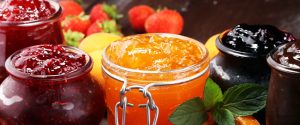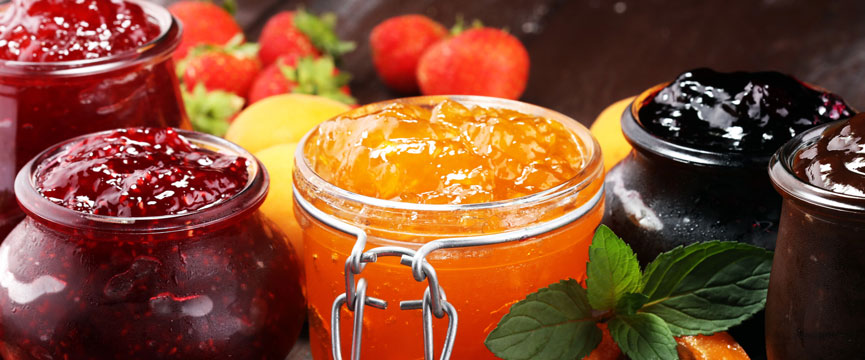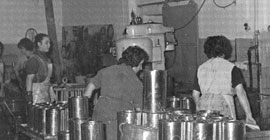 Making a good jam depends largely on the quality and characteristics of the fruit used in its preparation. For professionals, choosing the right fruit is key to guaranteeing a final product with the best flavor, texture and conservation. With this kind of jam you will be able to surprise your diners. In this post, we are going to analyze what are the best fruits to make jam. We will also explore its main characteristics and what professionals look for when choosing the best brands on the market.
Making a good jam depends largely on the quality and characteristics of the fruit used in its preparation. For professionals, choosing the right fruit is key to guaranteeing a final product with the best flavor, texture and conservation. With this kind of jam you will be able to surprise your diners. In this post, we are going to analyze what are the best fruits to make jam. We will also explore its main characteristics and what professionals look for when choosing the best brands on the market.

Table of Contents
Best fruits to make jam
To obtain a quality fruit jam, the fruit used in its preparation must meet certain criteria that, without a doubt, will influence the final result. Let’s look at it in more detail:
High pectin content
Pectin is a natural fiber present in many fruits and is essential to achieve the consistency that a good jam needs. Some fruits are naturally high in pectin, which facilitates the gelation process without the need for additional thickeners. Some examples of these fruits may be apple, quince, plum or currant.
Low pectin fruits
These fruits require the addition of pectin or combination with other pectin-rich fruits to obtain the proper texture in jam. Some examples of this type of fruit can be strawberries, mangoes, pears or figs.
Fruits with a moderate pectin content
Citrus fruits provide a fresh flavor and a balanced pectin content, making them ideal for making fresh jams with intense flavors. Orange, lemon or tangerine are some examples of these fruits.
Perfect balance between acidity and sweetness
The balance between acidity and sweetness is very important to obtain the perfect flavor in a jam, neither too cloying nor too sour. Fruits with a slight acidity provide greater freshness and enhance the flavor. In addition, they help to preserve the product. Some examples of fruits with a good balance of acidity and sweetness are red fruits (raspberry, blackberry and strawberry), apricot, peach and some types of orange.
Suitable texture
The firmness of the fruit is very important to prevent it from completely falling apart during the cooking process. A firm fruit allows some pieces or part of the pulp to be kept in the jam, which adds greater value to the consumer’s sensory experience when they try the product. Examples of firm fruits that allow a unique texture can be plum, fig or mango.
Intense flavor and aromas
A good jam should have a concentrated flavor that stands up to the cooking process. Fruits with intense flavors allow us to reduce the amount of sugar needed and maintain their identity in the final product. Some examples of fruits with intense flavors can be strawberry, passion fruit, fig or cherry.
For its part, fruits with a strong aromatic profile, such as raspberry or mango, allows professionals to produce jams with unique sensory experiences for consumers.
Adequate maturity
The point of maturity of the fruit is another very important aspect to take into account. The fruit must be at its exact point of ripeness to achieve the balance between sugar and acid. This is something essential to enhance the flavor and allow correct gelation.
An unripe fruit can be tasteless and, in the case of overripe, can affect the texture and pectin content. The end result would be an overly fermented flavor. Some examples of fruits that must be at their perfect point of ripeness are pear, peach, plum or blueberry.
Most used fruits for making jams
Some fruits are used more than others when making delicious, high-quality jams. Let’s see some of them:
- Strawberry: It is undoubtedly one of the most classic flavors of jam. It is widely used for its sweetness, softness and aroma. It has a moderate pectin content, so it usually requires a supplement, but its flavor makes up for any extra effort.
- Apricot: Its meaty texture and subtle acidity make it ideal for creating a balanced jam. It is widely used in baking due to its attractive bright orange color and also in cheese pairing.
- Peach: peach jam has a very peculiar yellow-orange color. It is sweet, juicy and with a silky texture, ideal for desserts and fillings.
- Raspberry: Raspberry is widely used to make gourmet jams, due to its vibrant red color, seedy texture, and intense flavor and aroma.
- Fig: It gives jams a unique grainy texture due to the seeds it contains. It has a very interesting flavor, with a slight earthy touch, ideal to combine with sweet or salty.
- Orange: Its citrus and slightly bitter flavor is ideal for making jams with a gelatinous texture due to its high pectin content. Its acid profile allows the natural flavors to stand out.
- Apple: The apple provides a soft and slightly acidic jam, with a dense texture due to its high pectin content. It is ideal to combine with spices such as cinnamon.
- Kiwi: This jam is quite acidic and has a vibrant and very exotic green color. It has the presence of small black kiwi seeds, which gives it a unique and refreshing touch.
- Blackberry: It has a very good balance of acidity and sweetness and is intensely fruity. It provides a thick texture and a very characteristic dark purple color.
What brands do professionals choose to make jam?
For professionals looking for quality fruits without worrying about seasonality, fruit pulps or purees are an excellent alternative if what they want is to make their own jams. In other cases professionals seek quality jams, already made, that meet the highest quality standards. There are brands with many years of experience in the market that guarantee products perfectly adapted to these demands, not only in terms of quality, but also with an extensive catalog and different formats and packaging.
In Lazaya Preserved Fruits, after more than 8 decades offering the best fruits to make jam, we also have a wide variety of jams, fillings, gels and jellies ready to be used. Professionals can use them in their more traditional preparations, but also in innovative products capable of surprising and delighting their customers. If you want to know more about our jams, do not hesitate to contact us, we will be happy to help you.









